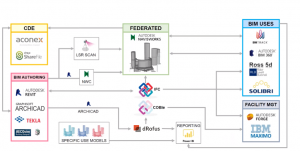A new integrated resort development is being constructed that will put Brisbane on the map as a tourism, leisure and entertainment destination
Expected to open in 2022, Queen’s Wharf Brisbane – a new integrated resort development – will transform the CBD and river’s edge with an iconic design that embraces Brisbane’s inviting subtropical climate.
- Client: Destination Brisbane Consortium
- Project type: Retail/Residential/Commercial
- Budget: $3.6bn
- Start date: 2017
- Estimated completion: 2024
- Location: Brisbane, Australia
The design also celebrates the precinct’s Indigenous and European heritage with interpretive trails and experiences spanning the Brisbane River and ridgeline.
DBM Vircon, previously known as PDC, is a highly experienced global BIM management, modelling, digital engineering and detailing services company.
Since its establishment in 1972, DBM Vircon has grown from a team of three to a global company with more than 385 personnel across offices in Australia, the Philippines and North America. DBMV is a software and vendor-agnostic organisation in order to provide independent and transparent services to their clients.
Gabor Gulyas, the operations manager at DBM Vircon, confirmed that five BIM collaboration software systems were reviewed and actively assessed before dRofus was selected for the task on Queen’s Wharf.
“Out of the 25,000 hours in this project, I’d say about 5,000 hours went to testing everything. For every requirement we set for the delivery team, we have tested various solutions to make sure that we don’t have false expectations,” said Gabor.
“dRofus proved to be the best tool to consolidate all of the data coming from all of the different sources and provide a single source of truth for exporting COBie outputs. The software was also very flexible when defining COBie export processes.”
Typically, to deliver COBie you have to create multiple schedules within model files, export to Excel, email the Excel files around, manually edit the Excel schedules, merge the Excel files together, fill in data that does not exist within the model – it’s a not a very BIM-like process and a challenge even on small projects.
DBM Vircon and the Queen’s Wharf team tested several tools and plug-ins to deliver COBie and they concluded that dRofus was the best solution and the leanest way to capture, coordinate and consolidate briefing, design and construction data.
The integrated resort development, Queen’s Wharf, is a flagship project for DBM Vircon
“Queen’s Wharf is a flagship project for DBM Vircon, pulling together a key team of highly skilled digital engineers to deliver a complex project with multiple interfaces, stages, programmes, software and teams. This allowed DBM Vircon to develop an integrated model that is already being tested in operations, some four years before delivery,” said Alastair Brook, DBM Vircon director of digital engineering.
dRofus was implemented quite late during the design stage but enabled design data capture, COBie workflows, tenancy planning and on-site activities via automated QR codes.
“Normally, dRofus is implemented during the briefing or concept design stage and this project just goes to show that it is never too late. Clients struggle with data management every day on projects and that pain goes away once they flip the dRofus switch,” said Chris Razzell, dRofus managing director.
The dRofus database played a key overarching role in pushing and pulling data from other BIM authoring platforms on the project. This included coordination and consolidation of room and serviceable item data from numerous Revit and Archicad models – creating the single source of truth.
By creating this common data environment, dRofus was able to play a pivotal role in key workflows such as design authoring and briefing, schedule and specification creation and production, special analysis and quantity take offs.
Furthermore, a key dRofus-based core workflow which should be highlighted was the method through which Asset Information Requirements (AIRs) for the proposed Facilities Management (FM) System – which still has a number of years before it will be operable – could be created in the design phase in a COBie-compliant template and extracted in an open IFC format.
This sort of upfront planning at design stage will pay dividends for the project efficiencies during the later stages of construction and operation.
 Design authoring and briefing of Queen’s Wharf
Design authoring and briefing of Queen’s Wharf
“dRofus provided a great tool to consolidate naming and numbering,” said Gabor Gulyas.
The Queen’s Wharf project has now started the construction phase, where access to design data and capturing Asset Information Requirements (AIRs) for facilities management handover will be the next big challenge – watch this space!
Asset management
- 49,000+ Lighting fixtures.
- 1,800+ Mechanical equipment.
- 3,300+ Duct accessories.
- 5,900+ Pipe accessories.
- 10,000+ Plumbing fixtures.
- 1,800+ Security devices.
- 1,800+ Sprinkler heads.
- 5,500+ Specialty equipment.
- 2,100+ Air terminals.
- 4,600+ Communication devices.
- 2,100+ Data devices.
- 3,300+ Duct accessories.
- 1,500+ Electrical equipment.
- 11,600+ Electrical fixtures.
- 800+ Fire alarm devices.
- 2,000+ Lighting devices.
- Over 100,000 serviceable items.
Dr. Roberto Schiera
Sales Representative EMEA
Tel: +49 0162 9438573
*Please note: This is a commercial profile













